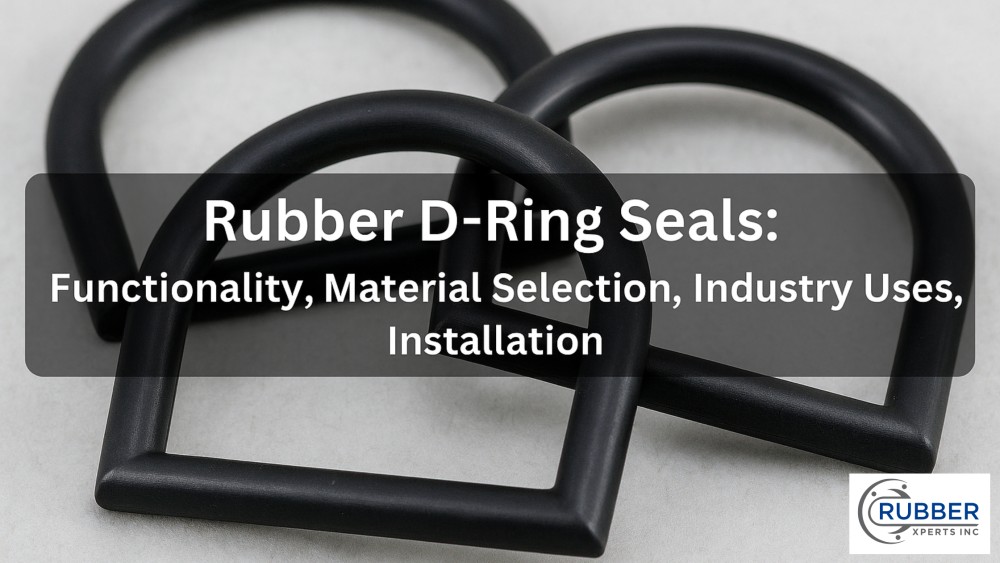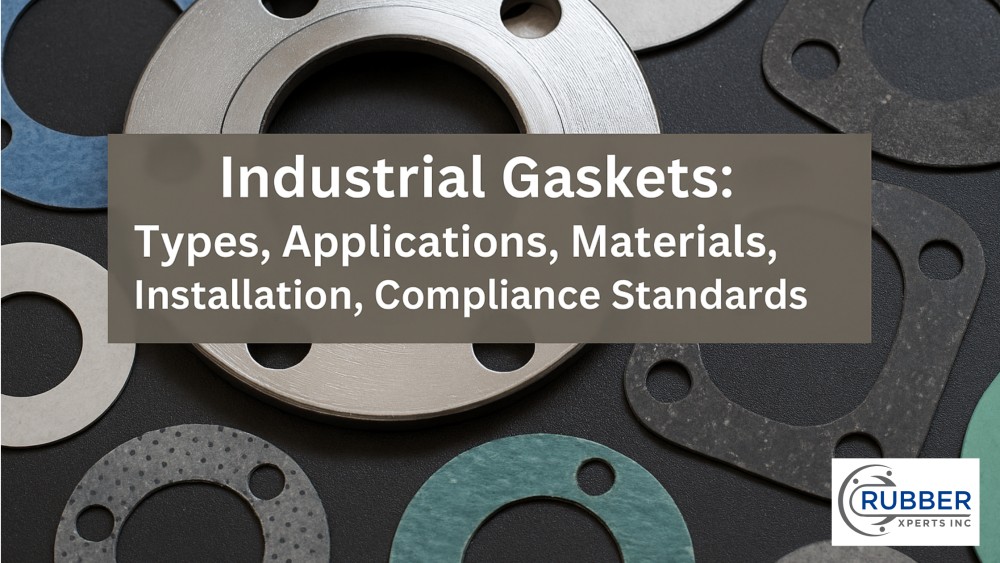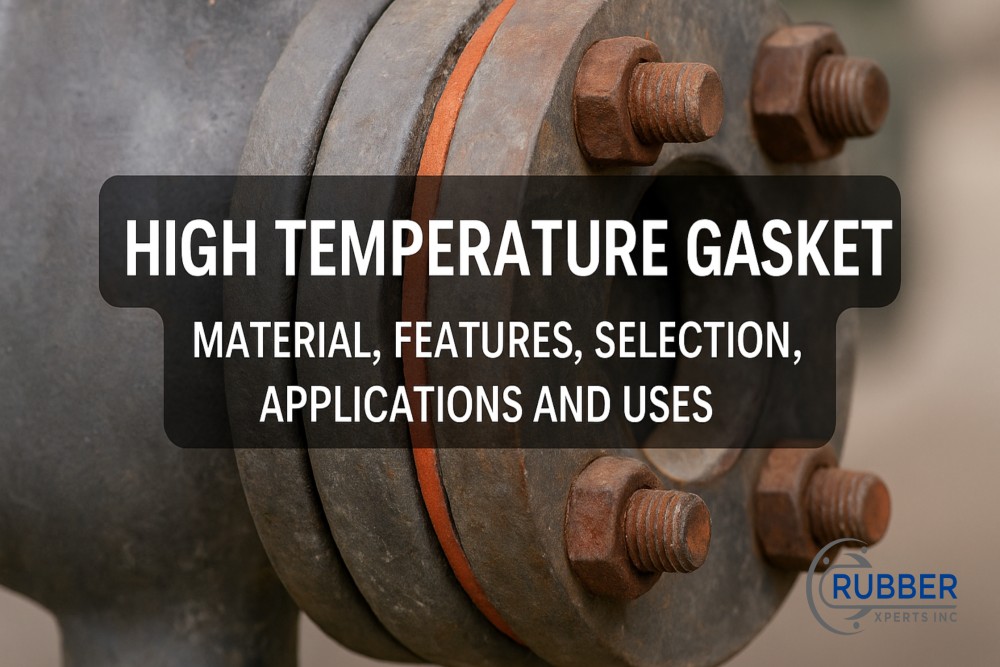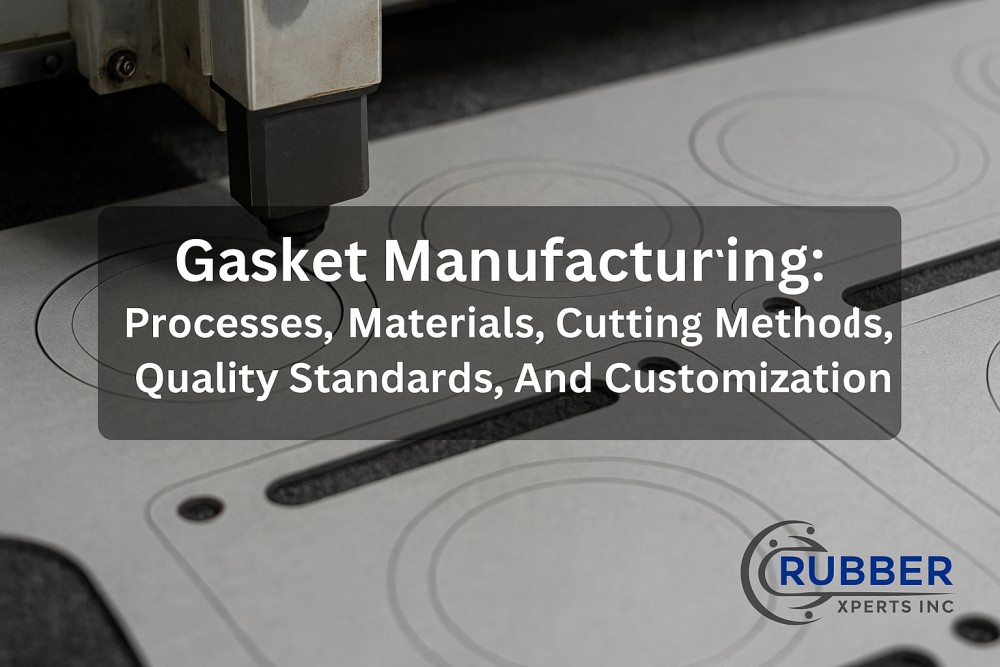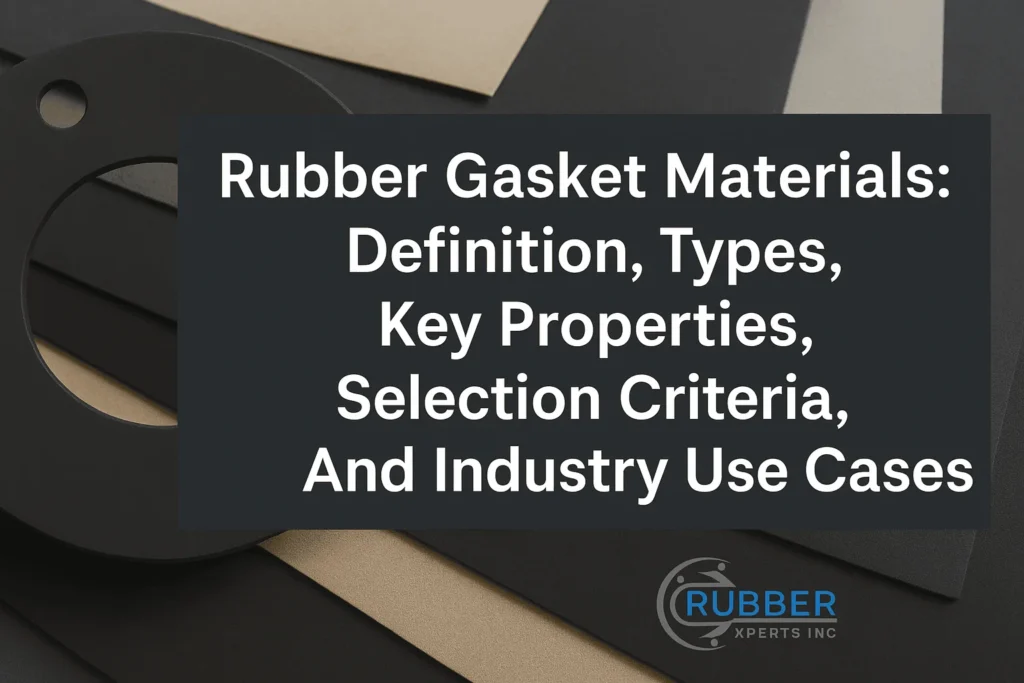Rubber extrusion shapes rubber materials into continuous profiles with defined cross-sections, creating versatile components for various uses. This manufacturing process relies on the plasticity of elastomers and their ability to retain flexibility and elasticity, making it necessary for producing extruded parts in multiple industries.
The rubber extrusion process involves feeding polymeric material into an extrusion machine, where it is heated, pressurized, and forced through a die to form a continuous profile. Following extrusion, the material undergoes vulcanization and finishing steps to enhance its durability and precision. This method ensures a smooth flow of material, producing high-quality parts for sealing, vibration control, and protection.
Rubber extrusion is classified into various types, including hot and cold extrusion, sponge and solid extrusion, and co-extrusion. Each type caters to specific needs. For instance, co-extrusion enables the combination of multiple rubber materials for improved performance. These types are designed to meet the demands of diverse industries, offering customized solutions for unique requirements.
A wide range of rubber materials is used in extrusion, such as natural rubber, silicone, and nitrile rubber. These materials are selected for their specific properties, such as resistance to heat, chemicals, or wear. The choice of material directly influences the durability and elasticity of the extruded parts, ensuring they meet industry standards for performance.
The applications of rubber extrusion span across industries like automotive, construction, and healthcare. It is integral in producing sealing components, protective tubing, and vibration-damping parts. The process’s adaptability enables the creation of custom profiles for a broad range of uses, ensuring functional and reliable solutions.
The advantages of rubber extrusion include cost efficiency, material flexibility, and reduced waste. This manufacturing process supports the production of intricate designs while maintaining durability and elasticity. The ability to create robust and versatile components makes rubber extrusion indispensable in meeting modern industrial demands.
What is Rubber Extrusion?
Rubber extrusion is a manufacturing process that shapes raw material rubber into continuous profiles with a consistent cross-section by forcing it through a shaped die under pressure. This method is commonly used to create uniform products such as seals, gaskets, and tubing.
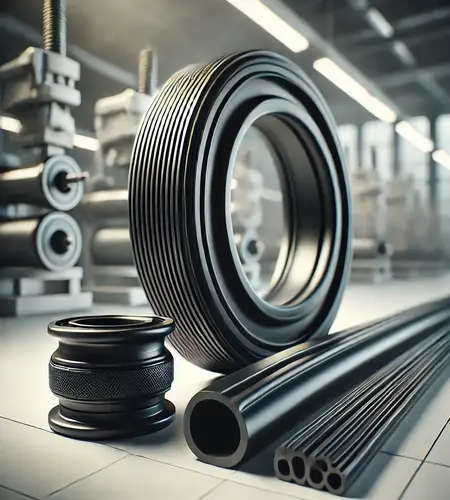
The process involves feeding an elastomeric compound into an extrusion machine, where it is heated and softened. The material is then pressurized and pushed through a hard tool or die with a specific profile. The shaped material undergoes vulcanization to set its final properties, ensuring flexibility and durability for various applications. The precision of the die and the control of temperature and pressure provide the quality and consistency of the extruded products.
Extruded rubbers are used primarily in industrial sealing to create highly reliable components that fit complex configurations. Their uniformity and ability to form custom shapes make them necessary for sealing applications in the automotive, construction, and manufacturing industries, where maintaining airtight and watertight seals is important for operational efficiency.
According to a report by Future Market Insights Inc. titled “Rubber Extruder Market,” the market was valued at US$ 2,278.73 million in 2021 and is projected to reach US$ 4,021.5 million by 2032, growing at a CAGR of 5.3% from 2022 to 2032.
What is the Process of Rubber Extrusion?
The process of rubber extrusion is a downstream operation where raw rubber is transformed into continuous flow profiles with specific cross-sectional profiles using specialized machinery. This shaping process involves multiple steps, each required to ensure the finished product meets industry standards for quality and performance, as studied by Limper A et al. 2002, in “Process Description for the Extrusion of Rubber Compounds.”
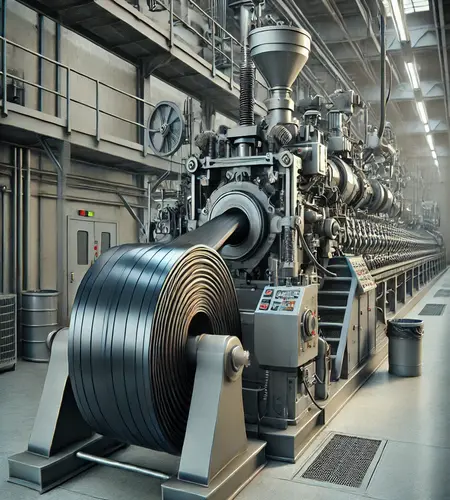
The process of rubber extrusion is as follows:
Material Selection
The process of rubber extrusion begins with selecting the appropriate type of raw rubber or rubber compounds based on the desired properties of the finished product. This step considers factors like flexibility, durability, and chemical resistance to ensure the material suits the intended application.
Rubber Compounding
During rubber compounding, the raw rubber is blended with additives such as fillers, plasticizers, and curing agents to achieve the desired mechanical and chemical properties. This step also optimizes the rubber for the extrusion process, improving its performance during pressure application and subsequent curing.
Feeding the Extruder
The prepared rubber compound is introduced into the extruder’s feeding system. A screw mechanism moves the material forward, ensuring a consistent supply for further processing. This step marks the starting point for the material’s transformation.
Heating and Pressurizing
As the rubber moves through the extruder, it passes through a heating or cooling system to achieve the desired temperature for shaping. Simultaneously, the material is subjected to pressure application, which softens it, making it suitable for extrusion through the die.
Extrusion Through the Die
The softened rubber is forced through an extrusion die, which shapes it into a continuous flow with the required cross-sectional profile. The precision of this step determines the uniformity and accuracy of the final product.
Vulcanizing and Curing Agents
After extrusion, the product undergoes curing or vulcanization to improve its strength, elasticity, and durability. Curing agents ensure the material achieves its final physical properties, making it suitable for end-use applications.
Cutting and Finishing
The extruded rubber is trimmed to the desired length and shape. Cutting or trimming ensures that the product meets the design specifications. Additional finishing processes are applied for quality control before it is considered ready for use.
What are the Different Types of Rubber Extrusion?
The different types of rubber extrusion processes include hot rubber extrusion, cold rubber extrusion, and specialized methods like co-extrusion. Each type employs unique techniques to create products tailored to specific applications in the rubber industry, such as seals and gaskets, consumer goods, and industrial components.
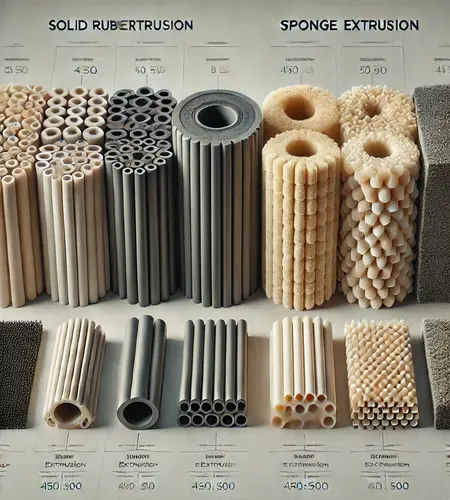
The different types of rubber extrusion are as follows:
Hot Rubber Extrusion
Hot rubber extrusion is a process in which raw rubber is heated to a pliable state before being passed through an extrusion die. This method is ideal for producing components with consistent texture and uniformity, such as sealing profiles and gaskets. The heat improves the flow of the rubber compound, making it suitable for complex shapes.
Cold Rubber Extrusion
Cold rubber extrusion processes rubber at lower temperatures, relying on mechanical force rather than heat to shape the material. This technique minimizes texture changes and is used for products requiring enhanced precision, durability, and biodegradability. It is particularly suited for seals and gaskets in challenging applications like material engineering.
Solid Rubber Extrusion
Solid rubber extrusion involves processing rubber compounds without introducing air or foaming agents. This method ensures the production of dense, durable products like industrial seals and conveyor belts, which require high strength and elasticity.
Sponge Rubber Extrusion
Sponge rubber extrusion incorporates gas or foaming agents during the process to create a lightweight, flexible material with a porous structure. Due to their excellent compression and sealing properties, these products are commonly used in closures and cushioning applications.
Custom Rubber Extrusion
Custom rubber extrusion customizes the process to meet specific requirements in industries like consumer goods, automotive, and construction. The process adapts to unique shapes, sizes, and material properties, ensuring bespoke solutions for challenging applications.
Co-Extrusion
Co-extrusion is a specialized process in which multiple rubber compounds are extruded simultaneously through a single extrusion die to create multi-layered products with distinct properties. Originating in the 20th century, this innovation combines polymer science with efficiency, producing items with enhanced chemical resistance, durability, and texture. According to a study by Nano Energy et al. 2021, titled “Co-excursion,” the process is used in the production of seals and gaskets, hoses, and other multi-functional components.
What Equipments are Used in Rubber Co-extrusion?
The equipment used in rubber co-extrusion are extruders, dies, and cooling systems, among others. These machines work in tandem to shape rubber materials into multi-layered products, ensuring uniformity and precision while maintaining desired properties through processes like bending and curing.
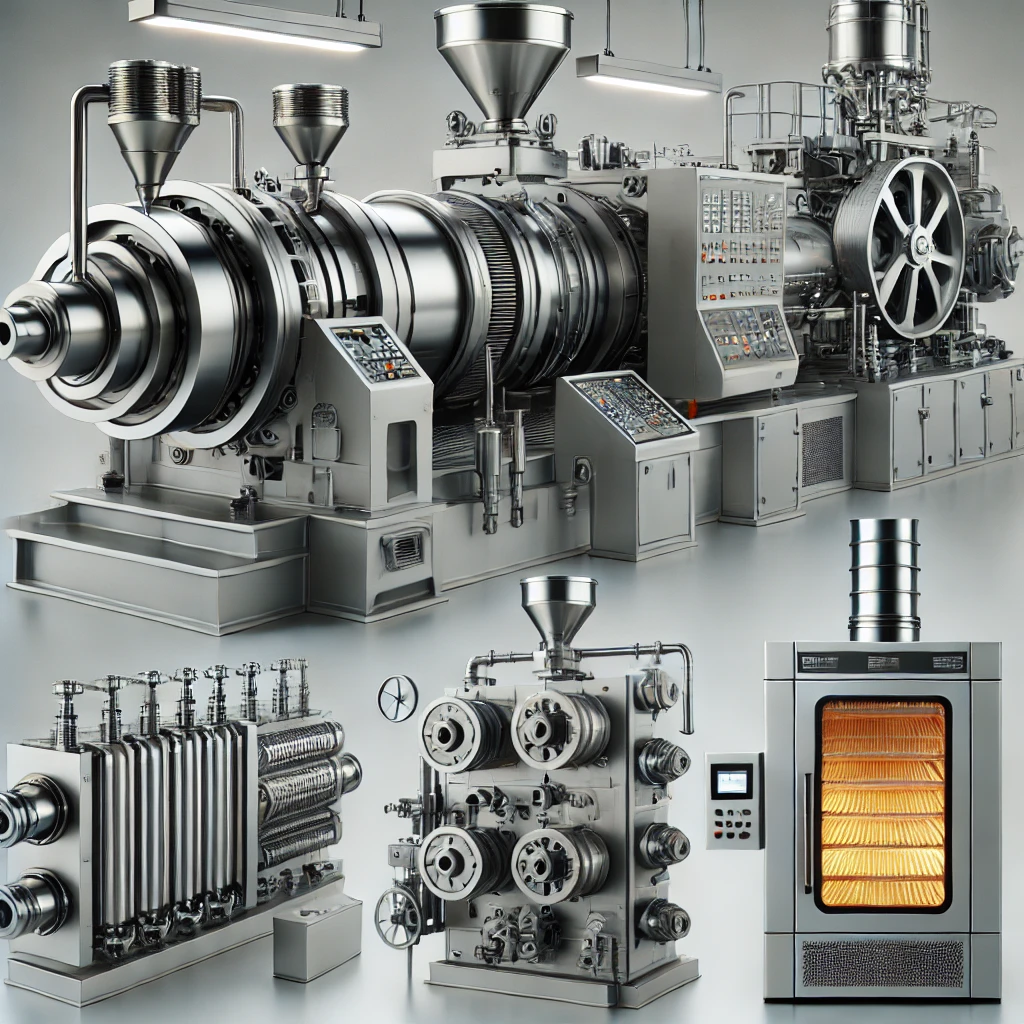
The equipment used in rubber co-extrusion are as follows:
- Extruders: Extruders are fundamental machines that pressurize and push rubber materials through a die, shaping them into the desired cross-sectional profile. In co-extrusion, multiple extruders are used to combine different materials into a single multi-layered product.
- Dies: The die is a necessary tool for determining the shape and size of the extruded material. In co-extrusion, the die ensures that the layers of different rubber compounds are seamlessly joined to form a uniform product with precise dimensions.
- Cooling Systems: Cooling systems cool down the extruded rubber to stabilize its structure and prevent deformation. This step is required to maintain product quality and ensure proper bending and flexibility without compromising durability.
- Curing Ovens: Curing ovens heat the extruded rubber to specific temperatures, enabling vulcanization. This process improves the elasticity and durability of the material, ensuring it meets the required specifications for industrial use.
What are the Advantages of Rubber Co-Extrusion?
The advantages of rubber co-extrusion are strength and durability, flexibility, and elasticity, as well as thermal and chemical resistance. These characteristics make it a versatile manufacturing process for high-performance applications in various industries. These benefits allow manufacturers to produce multi-functional rubber products efficiently and economically.
The advantages of rubber co-extrusion are as follows:
- Strength and Durability: Rubber co-extrusion combines multiple rubber materials to create products with enhanced strength and durability. This makes them ideal for demanding applications such as seals and gaskets in the industrial and automotive sectors, as studied by Lamnawar K et al. 2013, in “State of the art on the coextrusion process: fundamental and experimental approaches.”
- Flexibility and Elasticity: Co-extrusion retains rubber’s natural flexibility and elasticity while enabling precise control over material properties. This ensures that the final product withstands stress, bending, and deformation without damage.
- Thermal and Chemical Resistance: The co-extrusion process allows for the integration of materials with superior thermal and chemical resistance, ensuring that the co-extruded products perform effectively in harsh environments, including exposure to extreme temperatures and corrosive substances.
- Material Efficiency: By using different layers of rubber materials, co-extrusion minimizes waste and optimizes material usage, making it a cost-effective and environmentally friendly option for manufacturers.
- Production Efficiency: Rubber co-extrusion streamlines manufacturing by combining multiple processes into one. This reduces production time and costs while delivering consistent quality across large batches of products.
What are the Applications of Rubber Co-Extrusion?
The applications of rubber co-extrusion are automotive components, construction seals, and electronic insulation. It is a necessary process in industries requiring precision, durability, and flexibility. These applications benefit from coextrusion’s ability to produce multi-functional profiles tailored to specific needs.
The applications of rubber co-extrusion are as follows:
- Automotive Industry: Rubber co-extrusion is used in the automotive industry to manufacture seals, gaskets, and weatherstrips for doors, windows, and trunks. These components provide excellent flexibility and durability, ensuring long-term performance under varying conditions.
- Construction Industry: Co-extruded rubber profiles are important in construction for creating seals and gaskets in windows, doors, and expansion joints. These products ensure weather resistance and reduce energy loss, enhancing building efficiency.
- Electronics Industry: Co-extrusion is used to produce insulating profiles for wires and components. This improves thermal resistance and protects delicate electronics from environmental damage.
- Aerospace: Co-extrusion plays an integral role in aerospace, where it is used to manufacture seals and gaskets that withstand extreme temperatures, pressures, and chemical exposures. This ensures the safety and reliability of aircraft systems.
- Healthcare & Medical: The healthcare industry relies on co-extruded rubber for medical tubing, seals, and gaskets used in devices and machinery. These products maintain hygiene standards and provide necessary chemical resistance for medical applications.
What are the Materials Used for Rubber Extrusion?
The materials used for rubber extrusion are Butadiene Rubber, Styrene-Butadiene Rubber, and Nitrile Rubber, along with other specialized elastomers. Each material is selected based on its mechanical properties, durability, and resistance to environmental conditions. These materials allow for the creation of profiles that are customized to diverse industrial and commercial applications.
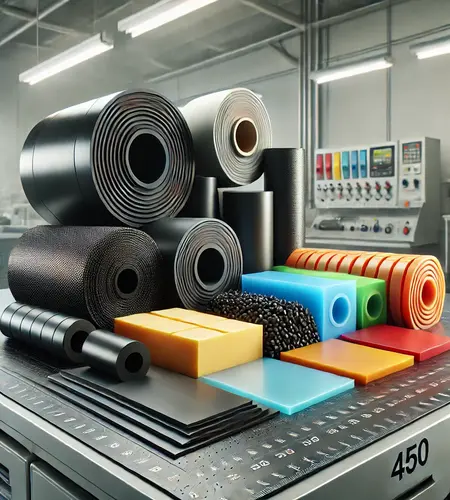
The materials used for rubber extrusion are as follows:
Butadiene Rubber
Butadiene Rubber is a synthetic elastomer known for its flexibility and abrasion resistance. Due to its ability to endure mechanical stress and maintain elasticity over time, it is commonly used in the production of tires, conveyor belts, and industrial seals.
Styrene-Butadiene Rubber
Styrene-butadiene rubber combines the properties of styrene and butadiene, offering excellent tensile strength and thermal stability. It is widely used to manufacture gaskets, seals, and other components requiring durability and resistance to wear.
Acrylonitrile Butadiene (Nitrile) Rubber
Nitrile Rubber is known for its superior oil resistance and chemical durability, making it ideal for use in automotive and industrial applications. It is a preferred choice for seals and gaskets exposed to fuels, oils, and other harsh chemicals.
Ethylene Propylene Rubber
Ethylene Propylene Rubber (EPR) is valued for its resistance to weather and ozone. It is commonly used in outdoor applications such as roofing membranes, window seals, and electrical insulation.
Butyl Rubber
Butyl Rubber is a versatile material known for its airtightness and moisture resistance. It is a staple in the production of inner tubes, seals, and medical devices.
Halogenated Butyl Rubber
Halogenated Butyl Rubber has improved chemical resistance and thermal stability owing to halogens. It is best suited for use in industrial equipment and pharmaceutical closures.
Chloroprene (Neoprene) Rubber
Neoprene Rubber is a durable, chemical—and weather-resistant elastomer used in automotive and marine applications, including hoses, gaskets, and protective covers.
Fluorocarbon (Viton) Rubber
Fluorocarbon Rubber offers exceptional resistance to high temperatures and chemical degradation. It is a preferred choice for seals and gaskets in aerospace and industrial applications.
Natural Rubber
Natural Rubber, derived from Latex, is prized for its elasticity and tear resistance. It is used in tires, conveyor belts, and shock absorbers.
Isoprene Rubber
Isoprene Rubber, a synthetic alternative to natural rubber, replicates its elastic properties but offers enhanced consistency and durability. It is used in seals, gaskets, and medical applications.
Silicone Rubber
Silicone Rubber is known for its thermal stability and biocompatibility, making it ideal for high-temperature seals, medical tubing, and consumer goods such as bakeware.
Polyurethane Rubber
Polyurethane Rubber combines abrasion resistance with elasticity, making it a popular choice for wheels, rollers, and seals in demanding industrial environments.
What are the Applications of Rubber Extrusion?
The applications of rubber extrusion are sealing fluids, conducting fluids, and absorbing energy, along with other specialized uses in diverse industries. These applications benefit from the flexibility, durability, and customization offered by the rubber extrusion process to meet specific functional requirements.
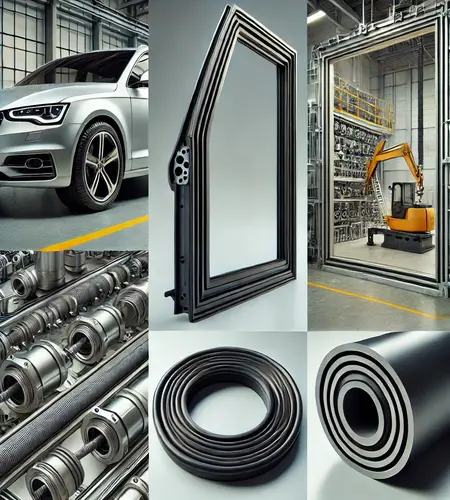
The applications of rubber extrusion are as follows:
Sealing Fluids
Rubber extrusions are integral in sealing applications, particularly in the industrial and automotive sectors, where they prevent fluid leakage. These seals are designed to withstand pressure variations and temperature extremes, ensuring the containment and controlled flow of liquids in complex machinery.
Conducting Fluids
Rubber extruded profiles, such as hoses and tubes, conduct fluids in various industries. Their chemical resistance and flexibility enable the smooth transportation of liquids and gases, making them fundamental in hydraulic systems and chemical processing plants.
Absorbing Energy
Rubber extrusions are used in components like vibration dampeners and shock absorbers. These products use rubber’s elastic properties to absorb energy and reduce mechanical shocks, protecting machinery and enhancing operational safety.
Connectors
Custom extruded rubber connectors are used to join pipes, tubes, and other components in systems requiring airtight or watertight seals. These connectors provide flexibility and strength, ensuring leak-proof connections in a variety of settings.
Tubing
Rubber extruded tubing is important in medical, automotive, and food-grade applications. Its durability and customizable cross-sections allow for precise fluid handling and secure connections in high-demand environments.
Gaskets
Extruded rubber gaskets reliably seal doors, windows, and machinery. Their adaptability to different shapes and resistance to wear makes them a better choice for construction and industrial applications.
Mandrel Formed Hoses
Mandrel-formed rubber hoses are designed for complex fluid transfer applications. They offer excellent flexibility and pressure resistance, making them ideal for automotive and aerospace applications.
Vibration Reducers
Rubber extrusions are used in vibration-reducing mounts and pads. These components isolate vibrations and noise in heavy machinery, ensuring smoother operations and reducing equipment wear.
Pressure Switch Square Tubing
Square tubing made from rubber extrusions is employed in pressure switch systems for its precision and ability to handle variable pressures, ensuring accurate functioning in industrial processes.
Door, Cabinet, and Window Seals
Rubber extrusions are extensively used to seal doors, cabinets, and windows. They provide weather resistance and improve energy efficiency. Their durability ensures long-term performance in residential and commercial settings.
What are the Advantages of Rubber Extrusion?
The advantages of rubber extrusion are quality, resistance, and cost savings, making it a preferred manufacturing process for producing durable and versatile rubber products. These benefits contribute to the efficiency and reliability of products used across various industries.
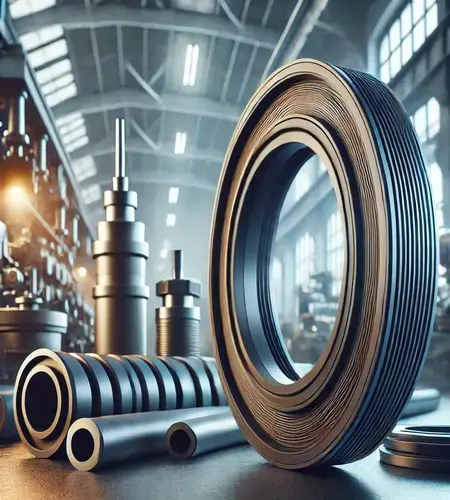
The advantages of rubber extrusion are as follows:
Quality
Rubber extrusion ensures high-quality output with precise shapes and dimensional accuracy. According to a study by Verheyen F et al., 2019, “The Extrusion of High-Consistency Silicone Rubber-a Process Analysis,” the process utilizes advanced machinery and consistent pressure to produce products with smooth finishes and uniform cross-sectional profiles. This precision makes extruded rubber ideal for applications requiring tight tolerances, such as seals and gaskets in demanding systems.
Resistance
Products created through rubber extrusion exhibit exceptional resistance to temperature fluctuations, chemicals, and mechanical wear. This durability stems from the ability to customize rubber compounds for specific environments, ensuring long-lasting performance in challenging conditions like industrial machinery and automotive components.
Cost Savings
Rubber extrusion is a cost-effective manufacturing method due to its high efficiency and minimal material waste. The continuous nature of the process reduces production time, while optimized material usage lowers expenses. These savings make it feasible to produce large volumes of high-quality rubber products at competitive costs.
Diversity
Rubber extrusion supports a wide range of materials and designs, enabling the creation of products for diverse applications. From simple tubing to intricate gaskets and profiles, the process allows manufacturers to meet specific requirements in sectors like construction, healthcare, and electronics.
Minimal Waste
The rubber extrusion process generates minimal waste, making it an environmentally friendly manufacturing option. By optimizing the use of raw rubber and recycling excess material, extrusion aligns with sustainable practices while reducing production costs and environmental impact.
What Comes after the Extrusion Process?
After the extrusion process, punching, cutting, and printing are common next steps to finalize and prepare the rubber product for its intended application. These processes improve the functionality, precision, and appearance of the extruded material, ensuring it meets specific industry standards and requirements.
After the extrusion process, the following processes are done:
Punching
Punching involves creating holes or specific shapes in the extruded rubber material using specialized tools. This process ensures that the rubber product meets precise design specifications, such as for seals, gaskets, and fluid transport components. Punching enhances the usability of rubber materials in applications requiring custom dimensions or perforations.
Cutting
Cutting is an important post-extrusion step that trims the rubber material to the desired length or shape. Using precision tools, this process ensures that the extruded product fits perfectly into its application, whether it’s tubing, door seals, or industrial gaskets. Accurate cutting minimizes waste and provides consistent quality.
Printing
Printing involves adding labels, logos, or technical details onto the surface of the extruded rubber product. This step ensures identification, branding, or compliance with industry standards. Printed details on rubber components are fundamental for traceability and proper usage in sectors like automotive, healthcare, and industrial equipment manufacturing.
Drilling
Drilling creates precise holes in the extruded rubber material for assembly or functional purposes. This process is required for products like gaskets or components that need to be fastened or combined with other parts.
Moulded Corners
Moulded corners enrich the flexibility and fit of extruded rubber profiles. This process ensures effortless installation in complex geometries such as window and door seals.
Riveting
Riveting is used to fasten rubber components to other materials. It provides a secure bond in applications such as industrial machinery or automotive assembly.
Grinding
Grinding smooths the edges or surfaces of extruded rubber to meet specific aesthetic or functional requirements. This process is important for producing high-quality, durable rubber components.
What are the Most Common Extruded Rubber Products?
The most common extruded rubber products are rubber bushings, rubber trims, rubber tubing, hoses, and piping. These products are widely used across industries due to their versatility, durability, and ability to meet specific application needs in various environments.
The most common extruded rubber products are as follows:
- Rubber Bushings
- Rubber Trims
- Rubber Tubing, Hoses, and Piping
- Rubber Bumpers
- Rubber Gaskets
- Rubber Cord Stock or O-rings
- Rubber Weatherstrips
- Medical Silicone Rubber Tubing
What is the Difference Between Extruded and Molded Rubber?
The main difference between extruded rubber and molded rubber is the manufacturing process. Extrusion involves forcing raw rubber through a die to create continuous profiles while molding shapes rubber by compressing it into pre-designed molds. These processes result in distinct characteristics suited for different applications.
The main differences between extruded and molded rubber are explained below:
| Aspect | Extruded Rubber | Molded Rubber |
| Manufacturing Process | Rubber is forced through a die to create a continuous profile. | Rubber is shaped by compressing it into a mold. |
| Applications | Tubes, seals, gaskets, and rubber weatherstrips. | O-rings, grommets, and custom-shaped parts. |
| Precision | It is less precise. | High precision for complex shapes. |
What are the Different Types of Extrusion Machines?
The main difference between extrusion machines is their operating mechanisms and intended applications. These include single-screw, twin-screw, and ram extruders, each designed for specific purposes such as polymer processing or high-pressure applications.
The differences between extrusion machines are as follows:
- Single-Screw Extruders: Single-screw extruders are commonly used for processing rubber compounds. These machines rely on a rotating screw to push the material through a die, which is most suitable for simple profiles.
- Twin-Screw Extruders: Twin-screw extruders feature two interlocking screws. These machines offer better mixing and are suitable for complex rubber blends or heat-sensitive compounds.
- Ram Extruders: Raw extruders use a piston to pressurize and push rubber through the die for rubber extrusion. It is used for high-viscosity materials or precise shaping.
What are the Basic Components of a Rubber Extruder?
The basic components of a rubber extruder are the barrel, screw mechanism, and die assembly. These parts work together to heat, pressurize, and shape raw rubber into the desired profile.
The basic components of a rubber extruder are as follows:
- Barrel: Barrels encase the extrusion process, maintaining proper heat and pressure for rubber flow.
- Screw Mechanism: The screw mechanism consists of a rotating screw that mixes, pressurizes, and pushes rubber toward the die.
- Die Assembly: Die assembly is a hard tool that shapes the rubber into a specific cross-sectional profile.
Can Natural Rubber Be Extruded?
Yes, natural rubber can be extruded, but it requires careful compounding to improve its stability and processability. Due to its high elasticity and raw stickiness, additional agents enhance its performance during the process of rubber extrusion.
Where to Get Extruded Rubber Products?
You can get extruded rubber products from specialized manufacturers, offering high-quality, custom solutions tailored to diverse industrial needs. Their expertise ensures precision and durability in every product.
Reputed custom extruded rubber manufacturers design premium products to meet your unique application needs. Partnering with such a trusted manufacturer ensures high-quality, durable solutions customized to your specifications, backed by expert guidance and reliable service.

